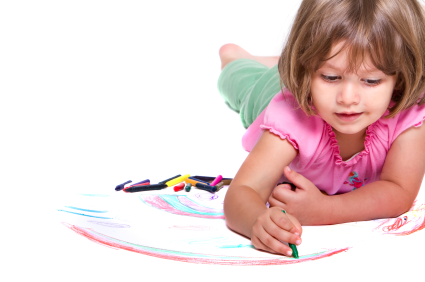 A little child gripping a paintbrush in her hand can quickly discover her “inner conductor.” Smocked in your old shirt and hovering over the kitchen table, arms raised, she conducts the swirl of colors on—and sometimes off—the page.
A little child gripping a paintbrush in her hand can quickly discover her “inner conductor.” Smocked in your old shirt and hovering over the kitchen table, arms raised, she conducts the swirl of colors on—and sometimes off—the page.
That’s just one small example of how music and art can go hand in hand. Plus, the same activities that develop musical skills in a young child also develop skills that a young artist needs: hand-eye coordination, creative expression, and visual literacy.
Want some ideas for bringing music and art together with your child? We’ve got some!
For Babies…
Your face is the artwork. You instinctively tend to hold your baby about eight to nine inches from your face—just close enough to provide her with needed visual stimulation. In the first two months of her life, that’s also her best field of vision. According to Carla Hannaford, author of Smart Moves, Why Learning is Not All in Your Head, sight is the least developed sense in a young baby. Most learning—almost 90 percent—occurs through touch and taste. Visual literacy (the ability to see texture and perspective in two-dimensional pictures) is learned later. You can help your baby develop visual literacy by showing her things that encourage her eyes to move. And in the first year of life, her favorite thing to look at is your face.
Your baby loves the contrast between your bright eyes and dark mouth, the many lines of your face, your facial expressions, and so on. The distance between your facial features begins to give your baby the information she needs to build her visual literacy.
Visual and auditory experiences actually shape the wiring of the brain. While seeing moving objects is not necessarily easy for infants, your newborn’s attention will also be attracted to bold, sharp patterns and objects. Showing your infant high contrast items such as black-and-white designs, brightly colored toys, and smiling faces is a great way to support his or her development.
Here are a few more activities to develop eye strength:
- > When you read together, trace your finger across the words as you read. This encourages your baby to follow your finger.
- > Hold and shake a rattle or instrument. Move it slowly allowing your baby to track the instrument with her eyes.
- > Sing. Research has shown that babies will turn their heads to look in the direction of the sound of their parent’s voice.
For Toddlers…
The development of your toddler’s drawing ability begins when the scribbling stage is over. Sometime between the ages of 12 and 18 months, your toddler will probably attempt to “write” by making marks on paper, and at about 18 to 24 months she may surprise you by drawing vertical and horizontal lines or a circle, according to Art and Creative Development for Young Children by Robert Schirrmacher.
The toddler years also mark a phase of drawing sometimes referred to as “Potato People.” These are drawings that feature wide bodies with stick figure legs and arms. Since your toddler spent so much time looking at your face as a baby, much of what he draws in the first year will be faces like these with appendages as an afterthought. Give him plenty of time with paper and crayons to help him develop his drawing skills and move beyond the “Potato People” phase (despite how cute those drawings end up being).
For a colorful activity, “paint” with tissue paper:
- > Cut the tissue paper into strips, or squares and put a very small amount of water into shallow bowls.
- > Show your toddler how to scrunch up the tissue and dip into the water to create a watercolor effect.
- > Encourage your toddler to tell you all about his creations. Talk about the colors, ask him about the shapes. To incorporate music, can you two make up a little song about the creation? Point and label—as you do with everything else in your toddler’s world.
For Preschoolers…
With preschoolers, you can dive in and draw to the music! With her increasingly abstract reasoning skills, her imagination is soaring. She’s also more physically coordinated and able to hold a pencil, crayons, and scissors with greater control. And while she enjoys being to able to draw more geometric shapes, much of the preschooler’s choice of color, is emotional, according to Art and Creative Development for Young Children.
What does the music look like? The emotional aspect of music, combined with tempo and rhythm, make drawing to music a perfect activity for this age.
- > To really get the imagination going, pick out some music and ask your preschooler to “draw out the music.” Ask him if this is blue music or red music. What would purple sound like?
- > Use the paper for wall art or wrapping paper. Glue it to bookmarks and give them to Grandma and Grandpa.

